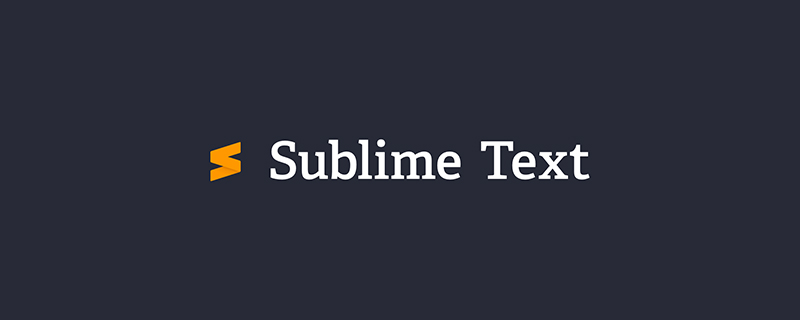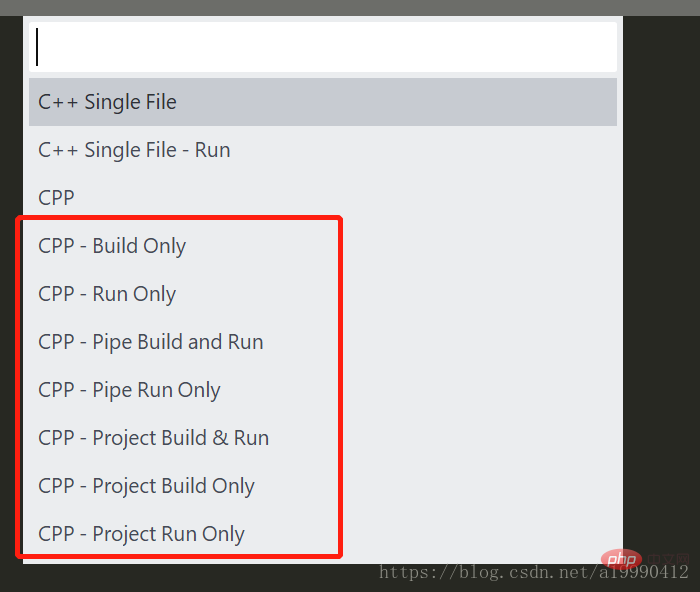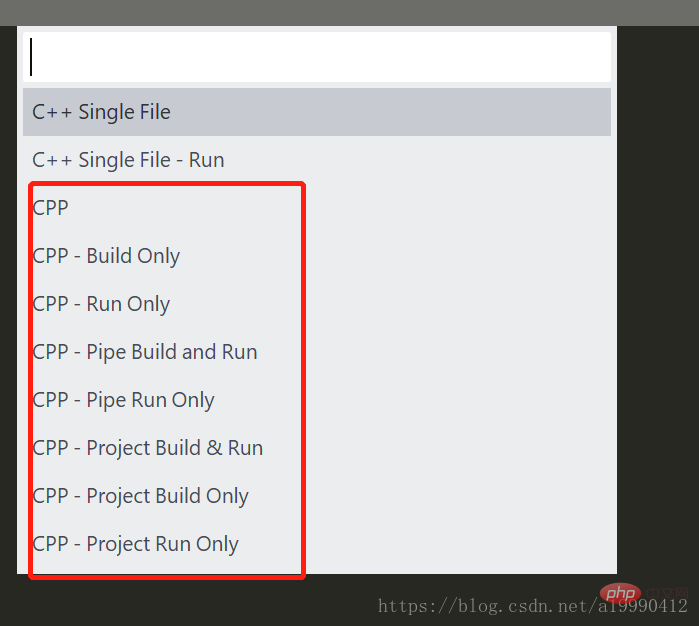 Development Tools
Development Tools
 sublime
sublime
 Detailed explanation of how sublime builds a C/C++ compilation environment
Detailed explanation of how sublime builds a C/C++ compilation environment
Detailed explanation of how sublime builds a C/C++ compilation environment
下面由sublime教程栏目给大家详解sublime搭建C/C++编译环境方法,希望对需要的朋友有所帮助!

sublime搭建C/C++编译环境(超完美的配置并配上内容详细讲解!!)
简述
有两台电脑,之前的电脑上就有之前好基友分享的cpp配置。
但是另外一台电脑上,一开始就没有配置这个。
然后,在网上搜,发现搜到的那些配置。抱歉,我的意思是,在坐的各位都是垃圾
我的C/C++的配置是这样的
-
操作方式: 点击**
工具,再选编译系统,再选新建编译系统** - 然后,把下面的代码,全部复制,并且,替换掉原来的那些地方。
- 之后保存就好了。 比如说,我保存的文件名就是
CPP.sublime-build
然后,我使用的时候,在选中了一个*.cpp文件,在键盘上输入**ctrl+b**(如果是第一次的话,会弹出下面的框,让你来选;否则就会需要输入ctrl+shift+b 这里关于输入法的必须选英文,否则会有表情包出来的。。)

- 就可以看到前置的那些选项了。最后面会讲解下,这几个选项的含义:
{
"cmd": ["g++", "${file}", "-std=c++11", "-o", "${file_path}\\\\${file_base_name}", "&", "start", "cmd", "/c", "${file_path}\\\\${file_base_name} & echo. & pause"],
"file_regex": "^(..[^:]*):([0-9]+):?([0-9]+)?:? (.*)$", "working_dir": "${file_path}",
"selector": "source.c, source.c++", "shell": true,
"encoding":"cp936",
"variants":
[
{
"name" : "Build Only",
"cmd":["g++", "${file}", "-std=c++11", "-o", "${file_path}\\\\${file_base_name}"]
},
{
"name" : "Run Only",
"cmd" : ["start", "cmd", "/c", "${file_path}\\\\${file_base_name} & echo. & pause"]
},
{
"name" : "Pipe Build and Run",
"cmd":["g++", "${file}", "-std=c++11", "-o", "${file_path}\\\\${file_base_name}","&","${file_path}\\\\${file_base_name}", "<","${file_path}\\\\in",">","${file_path}\\\\out"]
},
{
"name" : "Pipe Run Only",
"cmd" : ["${file_base_name}", "<","in",">","out"]
},
{
"name" : "Project Build & Run",
"cmd" : ["g++", "${file_path}\\\\*.cpp", "-std=c++11", "-o", "${file_path}\\\\project", "&", "start", "cmd", "/c", "${file_path}\\\\project & echo. & pause"]
},
{
"name" : "Project Build Only",
"cmd" : ["g++", "${file_path}\\\\*.cpp", "-std=c++11", "-o", "${file_path}\\\\project"]
},
{
"name" : "Project Run Only",
"cmd" : ["start", "cmd", "/c", "${file_path}\\\\project & echo. & pause"]
}
]
}含义讲解
-
CPP: 这个会编译当前文件,并弹出一个cmd命令框(运行这个程序)。 - 如果是
build的那就是只有编译的。 - 如果是
run的那就是只有运行 - 如果是
build&run那就是编译且运行。

- 第一个
CPP: 这个会编译当前文件,并弹出一个cmd命令框(运行这个程序)。 - 第二个
CPP-Build-Only就是会只编译一下。 - 第三个
CPP-Run-Only就是只运行一下。 - 第四个
CPP-Pipe Build and Run会在当前代码所在目录找,找到in文件(没有后缀)的内容作为输入,并且,输出给out文件(同样没有后缀) - 第五个
Pipe Run Only跟上面的唯一区别,就是不会编译。就只输出而已。 - 第六个
Project Build & Run就是将当前目录下的所有cpp文件,然后集合编译为一个文件,并且,输出为project.exe的文件,且执行该文件。 - 第七个
Project Build Only,只编译,不运行。 - 第八个
Project Run Only,只运行,不编译。
The above is the detailed content of Detailed explanation of how sublime builds a C/C++ compilation environment. For more information, please follow other related articles on the PHP Chinese website!

Hot AI Tools

Undresser.AI Undress
AI-powered app for creating realistic nude photos

AI Clothes Remover
Online AI tool for removing clothes from photos.

Undress AI Tool
Undress images for free

Clothoff.io
AI clothes remover

Video Face Swap
Swap faces in any video effortlessly with our completely free AI face swap tool!

Hot Article

Hot Tools

Notepad++7.3.1
Easy-to-use and free code editor

SublimeText3 Chinese version
Chinese version, very easy to use

Zend Studio 13.0.1
Powerful PHP integrated development environment

Dreamweaver CS6
Visual web development tools

SublimeText3 Mac version
God-level code editing software (SublimeText3)

Hot Topics
 1662
1662
 14
14
 1419
1419
 52
52
 1313
1313
 25
25
 1262
1262
 29
29
 1235
1235
 24
24
 What should I use to open html?
Apr 21, 2024 am 11:33 AM
What should I use to open html?
Apr 21, 2024 am 11:33 AM
To open HTML files you need to use a browser such as Google Chrome or Mozilla Firefox. To open an HTML file using a browser, follow these steps: 1. Open your browser. 2. Drag and drop the HTML file into the browser window, or click the File menu and select Open.
 What software is good for python programming?
Apr 20, 2024 pm 08:11 PM
What software is good for python programming?
Apr 20, 2024 pm 08:11 PM
IDLE and Jupyter Notebook are recommended for beginners, and PyCharm, Visual Studio Code and Sublime Text are recommended for intermediate/advanced students. Cloud IDEs Google Colab and Binder provide interactive Python environments. Other recommendations include Anaconda Navigator, Spyder, and Wing IDE. Selection criteria include skill level, project size and personal preference.
 How to open local file in html
Apr 22, 2024 am 09:39 AM
How to open local file in html
Apr 22, 2024 am 09:39 AM
HTML can be used to open local files as follows: Create a .html file and import the jQuery library. Create an input field that allows the user to select a file. Listen to the file selection event and use a FileReader() object to read the file contents. Display the read file contents on the web page.
 How to use the copied code in python
Apr 20, 2024 pm 06:26 PM
How to use the copied code in python
Apr 20, 2024 pm 06:26 PM
Here are the steps to use copied code in Python: Copy and paste the code into a text editor. Create a Python file. Run the code from the command line. Understand what the code is for and how it works. Modify the code as needed and rerun it.
 What can I use to open html?
Apr 21, 2024 am 11:36 AM
What can I use to open html?
Apr 21, 2024 am 11:36 AM
HTML files can be opened using a browser (such as Chrome, Firefox, Edge, Safari, Opera): find the HTML file (.html or .htm extension); right-click/long-press on the file; select "Open"; select the file you want to use browser.
 How to create py file in python
May 05, 2024 pm 07:57 PM
How to create py file in python
May 05, 2024 pm 07:57 PM
Steps to create a .py file in Python: Open a text editor (such as Notepad, TextMate, or Sublime Text). Create a new file and enter the Python code, paying attention to indentation and syntax. When saving the file, use a .py extension (for example, my_script.py).
 Which html editor software is easy to use?
Apr 17, 2024 am 04:54 AM
Which html editor software is easy to use?
Apr 17, 2024 am 04:54 AM
To sum up, the following HTML editors are highly praised: Visual Studio Code: Cross-platform, feature-rich, free and open source. Sublime Text: High performance, highly customizable, paid software. Atom: cross-platform, scalable, open source and free. Brackets: dedicated for front-end development, intuitive interface, open source and free. Notepad++: lightweight, fast, powerful, open source and free. When choosing an HTML editor, consider factors such as platform compatibility, functionality, extensibility, price, and user-friendliness.
 python command to copy code
Apr 20, 2024 pm 07:05 PM
python command to copy code
Apr 20, 2024 pm 07:05 PM
To copy a Python code block, just: 1. Select the code block; 2. Press Ctrl + C (Windows) or Command + C (Mac); 3. Move the cursor to the target location and press Ctrl + V (Windows) or Command + V (Mac).



